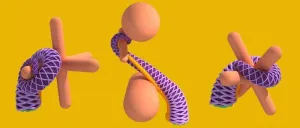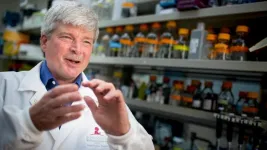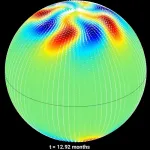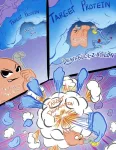(Press-News.org) Current guidelines recommend that pregnant people receive a vaccine against respiratory syncytial virus (RSV)—which typically causes mild, cold-like symptoms in most adults but can be deadly for infants—during weeks 32–36 of pregnancy. New research led by investigators at Mass General Brigham suggests that vaccination earlier in that timeframe, closer to 32 weeks, could provide the best protection for newborns against RSV. The findings are published in the American Journal of Obstetrics & Gynecology.
“Receiving the RSV vaccine in pregnancy is an important way mothers can protect their newborns and infants from RSV, the leading cause of hospitalization in U.S. infants,” said senior author Andrea Edlow, MD MSc, a maternal-fetal medicine specialist in the Department of Obstetrics and Gynecology at Massachusetts General Hospital, a founding member of the Mass General Brigham healthcare system. “However, it wasn’t clear whether it was equivalent to vaccinate at any time within the approved window, or whether specific weeks were most optimal. Because the RSV vaccine was ultimately approved for administration during a narrower gestational age window than was originally studied in the large clinical trial, more information was needed about how maternal antibodies travel across the placenta week over week across the approved window.”
Edlow and her team’s prior work evaluating prenatal administration of the COVID-19 mRNA vaccines demonstrated that timing of maternal vaccination was associated with altered maternal responses and transplacental antibody transfer to the fetus. To assess whether maternal vaccine timing is also an important consideration for RSV vaccination, the investigators measured RSV antibodies in the umbilical cord at the time of delivery among 124 women who received the RSV vaccine during weeks 32–36 of pregnancy and in the blood of 29 2-month-old infants of these mothers. All study participants were receiving care at Massachusetts General Hospital or Mount Sinai Health System in New York City. Levels of RSV antibodies can predict protection against RSV infection in infants too young to yet receive their own vaccines.
The investigators found that maternal RSV vaccination at least 5 weeks prior to delivery led to the most efficient transfer of maternal antibodies across the placenta to the newborn, compared with maternal vaccination at 2-3 or 3-4 weeks prior to delivery.
In an additional analysis, RSV antibody levels in maternal and cord blood after RSV vaccination were compared with RSV antibody levels in 20 unvaccinated mothers. Maternal RSV vaccination resulted in significantly higher and longer-lasting maternal and cord RSV antibody levels.
“This work provides much-needed data to guide physicians in counseling patients about RSV vaccine timing during pregnancy,” said Edlow. “Our findings suggest that being vaccinated earlier within the approved timeframe allows for the most efficient placental transfer of antibody to the newborn. They also may have implications for when the RSV monoclonal antibody, Nirsevimab, should be administered to newborns. Similar research should be conducted for other vaccines administered during pregnancy.”
The investigators noted that additional studies are needed to determine the minimum amount of antibody transfer and/or infant blood antibody levels needed to adequately protect infants against RSV. It will also be important to understand the potential additive protection for infants provided by breastmilk from RSV-vaccinated mothers. This study was designed to measure antibody transfer, but larger studies of infants 2 to 6 months of age will be needed to determine the extent to which this leads to enhanced protection.
Authorship: In addition to Edlow, Mass General Brigham authors include Olyvia J. Jasset, Paola Andrea Lopez Zapana, Lydia Shook, Emily Gilbert, Zhaojing Ariel Liu, Rachel V. Yinger, Caroline Bald, Caroline G. Bradford, Alexa H. Silfen, and Lael M. Yonker.
Disclosures: Outside of this work, Edlow serves as a consultant for Mirvie, Inc. and is a consultant for and has received research funding from Merck Pharmaceuticals. Additional disclosures can be found in the paper.
Funding: This work was funded by National Institute of Allergy and Infectious Disease (1U19AI167899, R01AI171980), the National Institute of Child Health and Human Development (5K12HD103096 to L.L.S; NIH/NHLBI: R01HL173059 to L.Y.; MGH ECOR: MGH Research Scholar Award to A.G.E., Claflin Award to L.L.S.; Binational Science Foundation Award number 2019075 to L.K. None of the funders had any role in the design of the study; in the collection, analysis and interpretation of data; in the writing of the report; nor in the decision to submit the article for publication.
Paper cited: Jasset OJ et al. “Enhanced placental antibody transfer efficiency with longer interval between maternal RSV vaccination and birth” AJOG DOI: 10.1016/j.ajog.2024.10.053
For More Information:
Mass General Brigham Prepares for Respiratory Virus Season
Tips to Prevent RSV
Study shows persistent antibodies in infants after COVID-19 vaccination in pregnancy
About Mass General Brigham
Mass General Brigham is an integrated academic health care system, uniting great minds to solve the hardest problems in medicine for our communities and the world. Mass General Brigham connects a full continuum of care across a system of academic medical centers, community and specialty hospitals, a health insurance plan, physician networks, community health centers, home care, and long-term care services. Mass General Brigham is a nonprofit organization committed to patient care, research, teaching, and service to the community. In addition, Mass General Brigham is one of the nation’s leading biomedical research organizations with several Harvard Medical School teaching hospitals. For more information, please visit massgeneralbrigham.org.
END
Study reveals best timing for getting the RSV vaccine during pregnancy to protect newborns
Mass General Brigham researchers found that getting vaccinated on the early side of the recommended window was best for transferring maternal antibodies to the fetus
2024-11-11
ELSE PRESS RELEASES FROM THIS DATE:
Could lights stop shark attacks
2024-11-11
Surfers could be protected from future shark attacks following new discoveries about how to trick sharks’ visual systems made by Professor Nathan Hart, head of Macquarie University’s Neurobiology Lab, Dr Laura Ryan and colleagues.
Hart, Ryan and their co-authors of a new paper in Current Biology titled Counterillumination reduces bites by Great White Sharks say their work “may form the basis of new non-invasive shark deterrent technology to protect human life”.
These researchers previously discovered that great whites place a high reliance ...
Alarming increase in alcohol use during pandemic persists
2024-11-11
Embargoed for release until 5:00 p.m. ET on Monday 11 November 2024
@Annalsofim
Below please find summaries of new articles that will be published in the next issue of Annals of Internal Medicine. The summaries are not intended to substitute for the full articles as a source of information. This information is under strict embargo and by taking it into possession, media representatives are committing to the terms of the embargo not only on ...
Pandemic-era increase in alcohol use persists
2024-11-11
LOS ANGELES — Alcohol use increased during the COVID-19 pandemic and remained elevated even after the pandemic ended, according to a large nationally representative Keck Medicine of USC study published today in the Annals of Internal Medicine.
From pre-pandemic (2018) to the height of the pandemic (2020), heavy alcohol use among Americans rose by 20%, and any alcohol use rose by 4%. In 2022, the increases were sustained.
The rise in drinking was seen across all age groups, genders, race, ethnicities and regions of the country, except for Native Americans and Asian Americans. Adults ...
A new milestone in the study of octopus arms
2024-11-11
Mechanical engineering PhD candidate Arman Tekinalp, fellow graduate student Seung Hyun Kim, Professor Prashant Mehta, and Associate Professor Mattia Gazzola, all from the Department of Mechanical Science and Engineering at the University of Illinois Urbana-Champaign, recently published in the Proceedings of the National Academy of Science (PNAS). Their interdisciplinary collaboration also included Assistant Professor Noel Naughton (formerly a Beckman fellow) from the Department of Mechanical Engineering at Virginia Tech alongside researchers from the Department of Molecular and Integrative Physiology at Illinois ...
Fighting microplastics for a cleaner future
2024-11-11
Microplastics, plastics smaller than 5 millimeters, are littered across the world, contributing to global warming, disrupting food chains, and harming ecosystems with toxic chemicals. This is why Dr. Manish Shetty is working to break down plastics before they can get into the environment.
Creating sustainable chemicals and developing better waste management will contribute to better sustainability. This research is part of figuring out how to make green hydrogen available for waste management using catalysts.
Shetty’s research uses solvents in low amounts that also act as hydrogen sources to break down a specific class of plastics called ...
Tumor suppressor forms gel-like assemblies to sacrifice cancer cells
2024-11-11
(MEMPHIS, Tenn. – November 11, 2024) There are processes in the human body that can suppress the growth and proliferation of cancer cells. These mechanisms, including those involving the tumor suppressor protein p53, are widely studied due to their critical role in disease. Through studies of proteins that regulate p53, scientists at St. Jude Children’s Research Hospital have uncoupled a previously unrecognized tumor suppression mechanism. Usually found at low levels in cells, the p14 Alternative Reading Frame protein (p14ARF) is expressed at higher levels under oncogenic stress and activates ...
New research uncovers how Barred Owls interact with urban areas and why it matters
2024-11-11
Baton Rouge, November 4, 2024 – Novel research just published in the American Ornithological Society journal, Ornithological Applications, has revealed noteworthy insights into how Barred Owls (Strix varia) interact with urban environments, with implications for both wildlife conservation and urban planning. This study, conducted by a team of biologists from Louisiana State University and other institutions, highlights the connection between owl habitat selection and an urban landscape, underscoring the ...
50 years of survey data confirm African elephant decline
2024-11-11
Habitat loss and poaching have driven dramatic declines in African elephants, but it is challenging to measure their numbers and monitor changes across the entire continent. A new study has analyzed 53 years of population survey data and found large-scale declines in most populations of both species of African elephants.
From 1964-2016, forest elephant populations decreased on average by 90%, and savanna elephant populations fell on average by 70%. In combination, populations declined by 77% on average. The study compiled survey data from 475 sites in 37 countries, making it the most comprehensive assessment of African elephants to date.
Declines ...
Swirling polar vortices likely exist on the Sun, new research finds
2024-11-11
EMBARGOED: Until 3 p.m. ET on Monday, Nov. 11, 2024
Contacts:
Laura Snider, NSF NCAR and UCAR Manager of Science Communications
lsnider@ucar.edu
303-827-1502
David Hosansky, NSF NCAR and UCAR Manager of Media Relations
hosansky@ucar.edu
720-470-2073
Like the Earth, the Sun likely has swirling polar vortices, according to new research led by the U.S. National Science Foundation National Center for Atmospheric Research (NSF NCAR). But unlike on Earth, the formation and evolution of these vortices ...
Protein degradation strategy offers new hope in cancer therapy
2024-11-11
RIVERSIDE, Calif. -- In drug discovery, targeted protein degradation is a method that selectively eliminates disease-causing proteins. A University of California, Riverside team of scientists has used a novel approach to identify protein degraders that target Pin1, a protein involved in pancreatic cancer development.
The team reports today in the Proceedings of the National Academy of Sciences that it has designed agents that not only bind tightly to Pin1 but are designed to cause its destabilization and cellular ...
LAST 30 PRESS RELEASES:
Exposure to natural light improves metabolic health
As we age, immune cells protect the spinal cord
New expert guidance urges caution before surgery for patients with treatment-resistant constipation
Solar hydrogen can now be produced efficiently without the scarce metal platinum
Sleeping in on weekends may help boost teens’ mental health
Study: Teens use cellphones for an hour a day at school
After more than two years of war, Palestinian children are hungry, denied education and “like the living dead”
The untold story of life with Prader-Willi syndrome - according to the siblings who live it
How the parasite that ‘gave up sex’ found more hosts – and why its victory won’t last
When is it time to jump? The boiling frog problem of AI use in physics education
Twitter data reveals partisan divide in understanding why pollen season's getting worse
AI is quick but risky for updating old software
Revolutionizing biosecurity: new multi-omics framework to transform invasive species management
From ancient herb to modern medicine: new review unveils the multi-targeted healing potential of Borago officinalis
Building a global scientific community: Biological Diversity Journal announces dual recruitment of Editorial Board and Youth Editorial Board members
Microbes that break down antibiotics help protect ecosystems under drug pollution
Smart biochar that remembers pollutants offers a new way to clean water and recycle biomass
Rice genes matter more than domestication in shaping plant microbiomes
Ticking time bomb: Some farmers report as many as 70 tick encounters over a 6-month period
Turning garden and crop waste into plastics
Scientists discover ‘platypus galaxies’ in the early universe
Seeing thyroid cancer in a new light: when AI meets label-free imaging in the operating room
Neutrophil-to-lymphocyte ratio may aid risk stratification in depressive disorder
2026 Seismological Society of America Annual Meeting
AI-powered ECG analysis offers promising path for early detection of chronic obstructive pulmonary disease, says Mount Sinai researchers
GIMM uncovers flaws in lab-grown heart cells and paves the way for improved treatments
Cracking the evolutionary code of sleep
Medications could help the aging brain cope with surgery, memory impairment
Back pain linked to worse sleep years later in men over 65, according to study
CDC urges ‘shared decision-making’ on some childhood vaccines; many unclear about what that means
[Press-News.org] Study reveals best timing for getting the RSV vaccine during pregnancy to protect newbornsMass General Brigham researchers found that getting vaccinated on the early side of the recommended window was best for transferring maternal antibodies to the fetus







